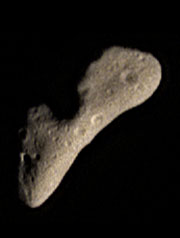geotimesheader
News
Notes
No Longer
a NEAR miss
| In December of 1998, the first of NASA’s “faster, better, cheaper”
Discovery missions was in trouble. Having already collected important data
from asteroid 253 Mathilde, the Near-Earth Asteroid Rendezvous (NEAR) spacecraft
was intended to begin its orbit of asteroid 433 Eros. Instead, NEAR sailed
past its target at a distance of more than 3,827 kilometers and at a speed
of over 965 meters per second.
On Feb. 14 this year, NEAR had a second chance. On that day, the probe
— recently renamed NEAR Shoemaker in honor of planetary science
pioneer Eugene Shoemaker — successfully entered into orbit around Eros.
The first high-orbit data, taken from a distance of about 325 kilometers,
were only a taste of what the researchers expected as the spacecraft approached
its closest orbit 50 kilometers from the asteroid’s center.
Visual images collected by the probe’s Multispectral Imager showed a
surface covered with craters. But many other bombarded bodies in the solar
system are marked with craters, making Eros’ surface “special, but not
unique,” said NEAR team member Clark Chapman of the Southwest Research
Institute. Chapman and colleagues announced initial NEAR findings at the
31st Lunar and Planetary Science Conference held March 13-17 in Houston. |

| On Feb. 12, during final approach
prior to orbit, NEAR Shoemaker captured the butterscotch hues
of Eros, still 1,800 kilometers away. Photo from Johns Hopkins University's
Applied Physics Laboratory. To see daily images of Eros visit http://near.jhuapl.edu/NEAR |
|
Usually, crater densities can be used to estimate the duration of an
orbiting body’s exposure to space debris. However, Eros has been in near-Earth
orbit for an unknown length of time and far from the densely inhabited
asteroid belt where its craters were likely produced. As a result, the
asteroid’s age will probably remain a mystery even as image resolutions
improve later this year.
Of particular interest to the NEAR researchers is the successful performance
of the probe’s suite of detection equipment. All of the instruments that
were designed to collect data from high orbit are online and working correctly.
One instrument, the X-ray/gamma-ray spectrometer, was meant to collect
substantial data only at low orbit. However, a 300-second solar flare on
March 2 provided an unusual illumination of Eros’ surface, allowing the
instrument to detect magnesium, aluminum, silicon, calcium and iron.
The gamma-ray spectrometer has also proven to be a valuable detector
of the most energetic events that occur in our universe, gamma-ray bursts,
said NEAR team member Jacob Trombka of NASA’s Goddard Space Flight Center.
A software patch applied to the instrument after launch enables NEAR
Shoemaker to detect the enigmatic blasts as part of the Interplanetary
Gamma-Ray Burst Timing Network.
The network, comprised of a fleet of spacecraft that include Ulysses
and Mir, can pinpoint the bursts with far greater accuracy since
NEAR
Shoemaker joined the search. Burst sources are now being discovered
at a rate of about one per week.
Josh Chamot

